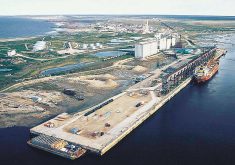World Food Day on Oct. 16 shed light on some confusing twists around global food security.
The annual UN Food and Agriculture Organization (FAO) event dating back to 1945 now falls five days after another big day — World Obesity Day, established by the World Obesity Foundation in 2015 to highlight the growing epidemic expected to threaten the health of one-third of the world’s population by 2025.
Meanwhile, farmers in this part of the world have risen to the “feed the world” challenge — so much so that they are caught up in an inverse relationship between increased production and lower prices.
Read Also

Your best (and easiest) holiday dainty tray
Make-ahead recipes, store-bought goodies and co-operation with friends and family: Here’s how to throw together a stunning, low-stress tray.
University of Nebraska PhD student Michael Castle recently captured that conundrum in his thesis exploring whether “precision agriculture” — high-tech but expensive equipment for precise application of fertilizer and chemicals — is increasing profits on Nebraska farms.
“In addition to the increased demand from a rising world population, producers are also facing increased pressure for efficiency with the recent downturn in commodity prices and increases in production expense. With commodity prices near and below break-even levels, there is a great need for producers to decrease costs and thus lower their break-even,” he writes in the introduction to his dissertation.
For the record, he found that farmers who have the money buy into precision agriculture technology, but whether that technology actually contributed to their profitability remains unclear.
The question that emerges however, is this: if there is increasing world demand for food, why are prices at near and below break-even? Secondly, usual supply-and-demand pressures would suggest farmers should respond to lower prices by producing less. However, in practice, farmers compensate for lower prices by trying to produce more.
Disconnects like these help explain why we are seeing some shifts in the messaging around food security in the 21st century.
Increasingly, the FAO is stepping back from its traditional focus on simply producing more food to feed a hungry world, and putting more emphasis into highlighting why people don’t have enough of the right kinds of food to eat, and the need to focus on sustainable production systems. There is also much more focus on nutrition — not just calories.
Just four years ago, the UN agency was saying the world’s farmers must increase production by 70 per cent to feed a population of 9.6 billion by 2050.
Today it is saying production must increase 50 per cent to feed 10 billion by 2050. The need for increased production is shrinking even though population projections are growing. There is also more emphasis on addressing the root causes of hunger — which almost always come down to various combinations of poverty, environmental collapse and war.
“There is more than enough food produced in the world to feed everyone, yet 815 million people go hungry,” says the 2017 State of World Food Security and Nutrition report.
In fact, after a decade of declines, the number of undernourished people on the planet has increased, rising from 777 million to 815 million in 2016, mainly in regions hardest hit by military conflict and climate change. A huge factor in rising food insecurity is the number of refugees or migrants resulting from those upheavals.
In 2015, there were 244 million international migrants, representing an increase of 40 per cent since 2000, the FAO says.
“Food security is a complex condition requiring a holistic approach to all forms of malnutrition, the productivity and incomes of small-scale food producers, resilience of food production systems and the sustainable use of biodiversity and genetic resources,” the FAO report says.
That often gets lost in the rhetoric promoting production-enhancing technologies to farmers in the developed world, technologies that are of little use to farmers working with hoes.
Catherine Bertini, formerly the executive director of the UN’s World Food Program, put some context around the productivity challenges facing the world’s farmers when she was in Winnipeg to address the Agricultural Bioscience International Conference last month.
She said, the productivity focus is needed on smallholder farmers, many of whom are women. Their needs are deceptively simple: secure access to land, credit, processing and markets.
“We have to support the development of agriculture in poor countries so that people can help build their own economic base so they can become international customers,” she said in an interview.
It seems the best way to achieve global food security — and to increase demand for what our farmers have to sell.
History has shown that as farmers become more productive, so does a country’s economy, which makes it possible for the growing middle class to create the kind of demand that pays.















